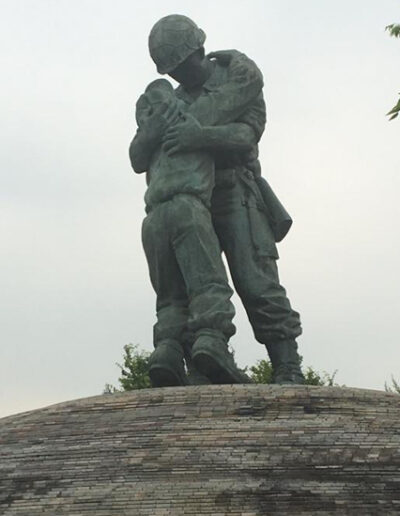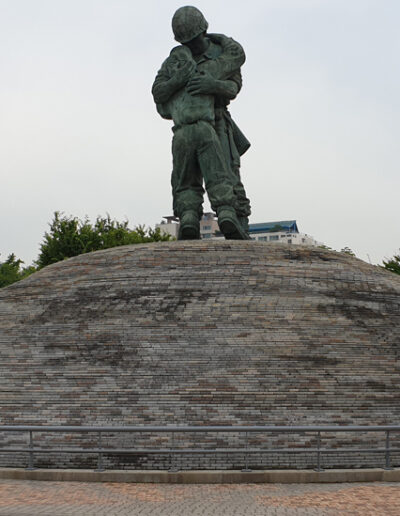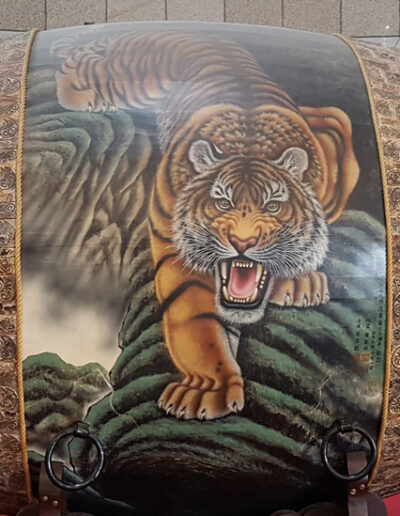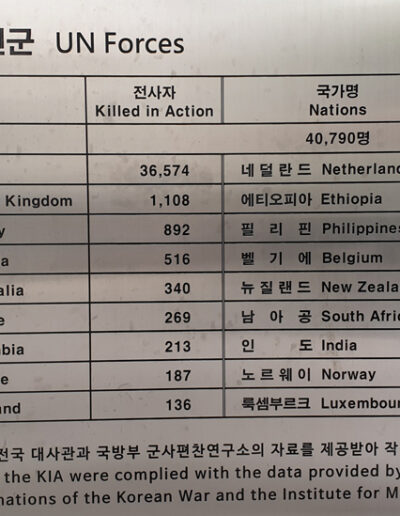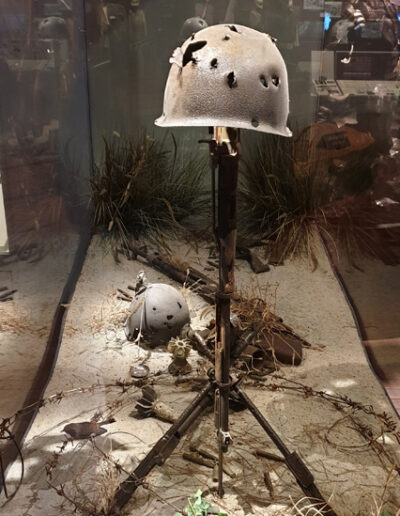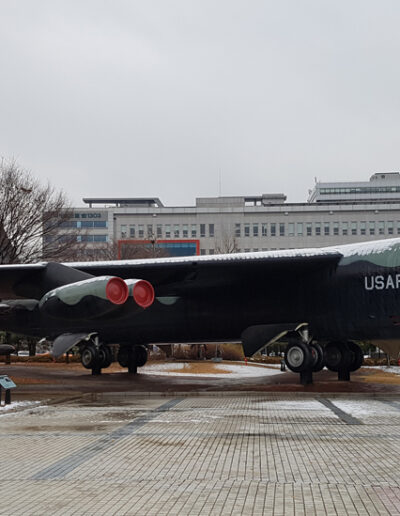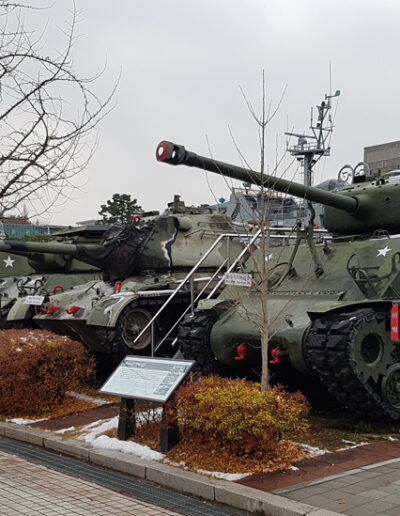The Statue of Brothers
1994
About the Object
Story of the Object
Teaching suggestions
Classroom Extras
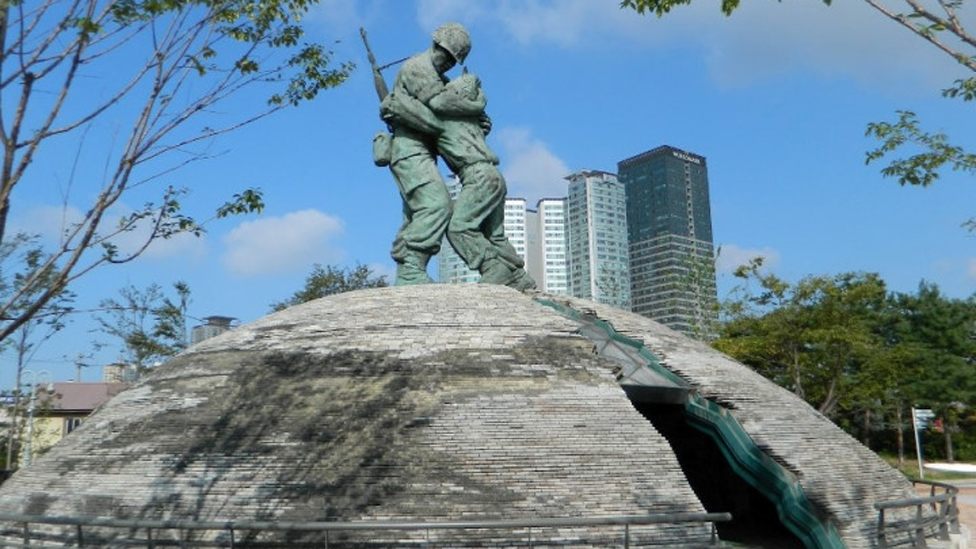
The Statue of Brothers at The War Memorial of Korea © Peace Learner
The Statue of Brothers
For the people of South Korea, the Statue of Brothers is a symbol of the Korean War.
It is perhaps one of the largest symbols of the war because the statue is 11 metres high and at its base it is 18 metres wide.
It is situated in the plaza at the front of the War Memorial of Korea in Seoul.
As a result, it dominates the area and is one of the first things seen by visitors to this important site.
The statue was created by the Korean architect Choi Young-jeep and is composed of two soldiers who are embracing standing upon a dome.
The statue depicts a scene from the Korean War when two brothers meet on the battlefield – the older brother is an officer in the army of the Republic of Korea (the South) and the younger brother is a soldier in the army of North Korea.
The brothers are shown with the older brother clearly supporting his younger sibling.
In this way the statue is also a very poignant symbol of the Korean War.
This is because it represents, as noted on the information board in front of the statue, that the meeting and the embrace symbolise an expression of, “reconciliation, love, and forgiveness”.
The statue is part of the War Memorial of Korea which is located in the former Army Headquarters in Yongsan and was opened in June 1994.
It is designed as a memorial to pay tribute to all those who fought in the war, as a museum telling the story of the Korean War and other conflicts, and as an urban park.
In all approximately 9,500 items are on display and it is claimed to be the largest landmark of its kind in the world.
The memorial and museum are extremely popular places for people to visit, both those from abroad as well as citizens of South Korea.
The Statue of Brothers and the War Memorial of Korea
The Statue of Brothers dominates the approach to the War Memorial and is an integral part of the outdoor area known as the Peace Plaza.
As a result, it is appropriate to consider the context of the whole site in which it is situated.
The Korean War between what became The Democratic People’s Republic of Korea (North Korea) and the Republic of Korea (South Korea) lasted for just over three years, from June 1950 to July 1953.
However, the death, destruction and cost of the war was so immense that the government and people of South Korea were determined that the War should not be forgotten, the events should be remembered, and the sacrifices of all those who took part and were affected by the fighting and its impact should be honoured.
It is with these considerations in mind that the architect Lee Sung-gwan designed the War Memorial of Korea.
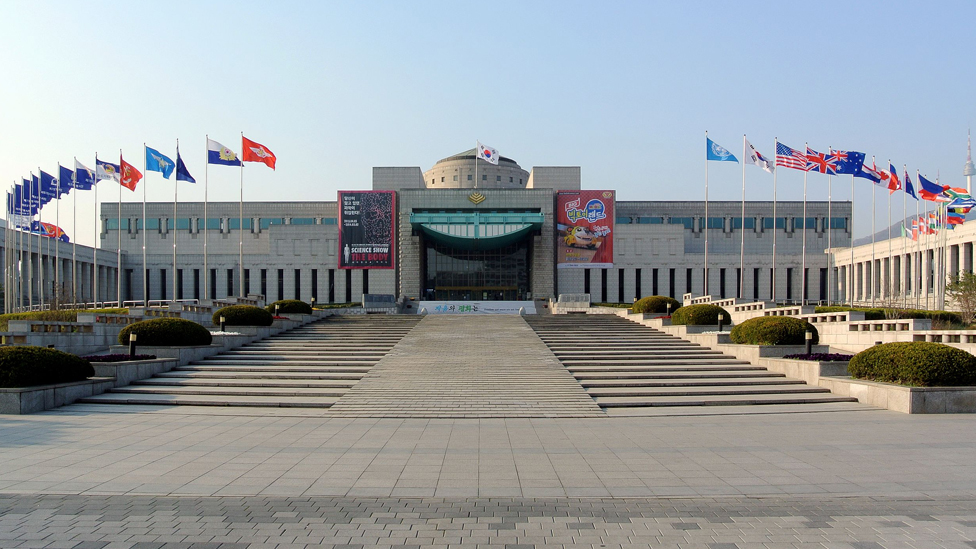
The front of the War memorial of Korea in Seoul
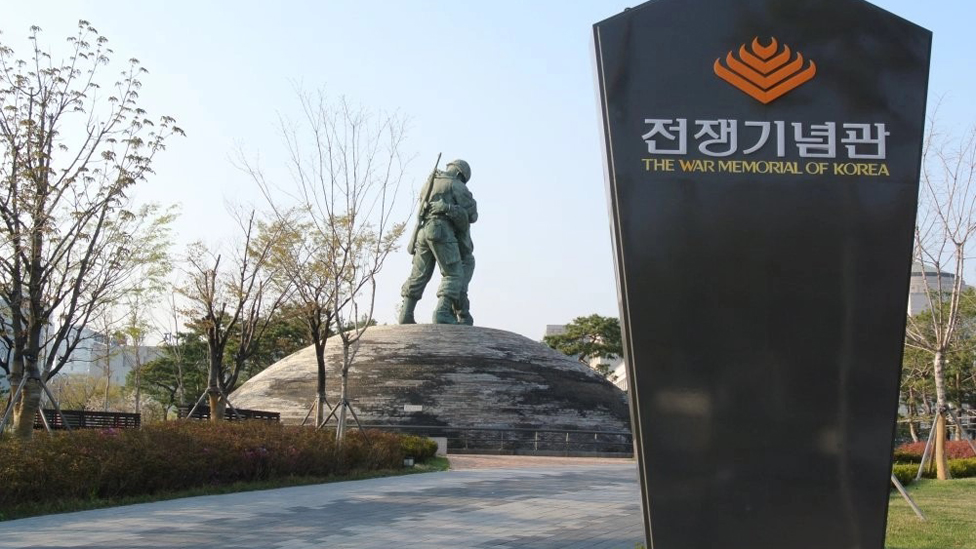
The approach to the Statue of Brothers and the War Memorial of Korea
It is a place of commemoration with a series of indoor rooms which explore, amongst other things, the War and its impact, an outdoor area with large sized exhibits, and a Peace Plaza.
The inner part of the Peace Plaza has 21 flags representing the 21 countries that participated in the War.
There are also 21 monuments, one for each participating country, which display in the respective language of the country, the country’s name, the period and scale of the participation, the total number of participants, the number of wounded, and the number killed.
There is also a Killed in Action section.
This is a series of 204 monuments giving the names of all those killed in the war, including the 40,000 UN forces as well as the 170,000 soldiers and other combatants who have been killed in action since the establishment of the South Korean army.
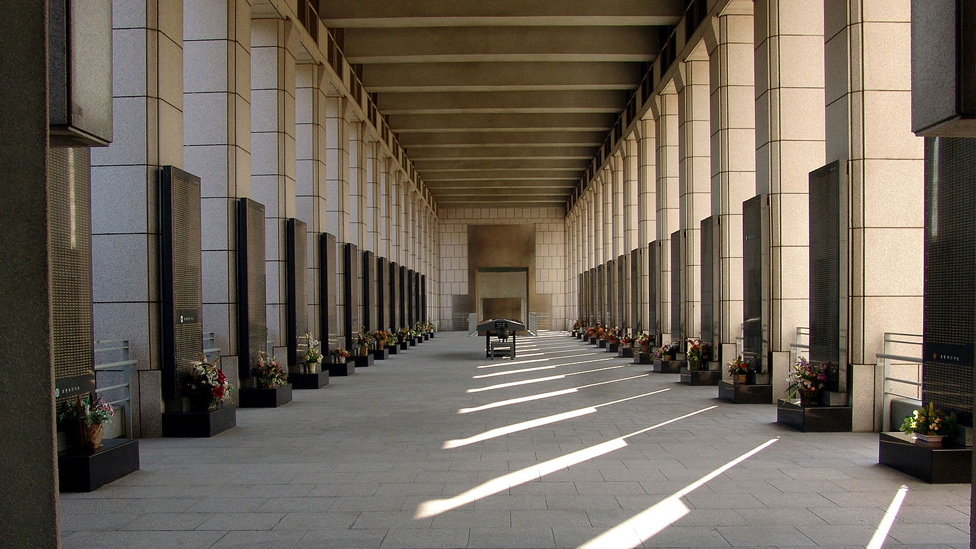
The monuments for the Killed in Action at the War Memorial of Korea
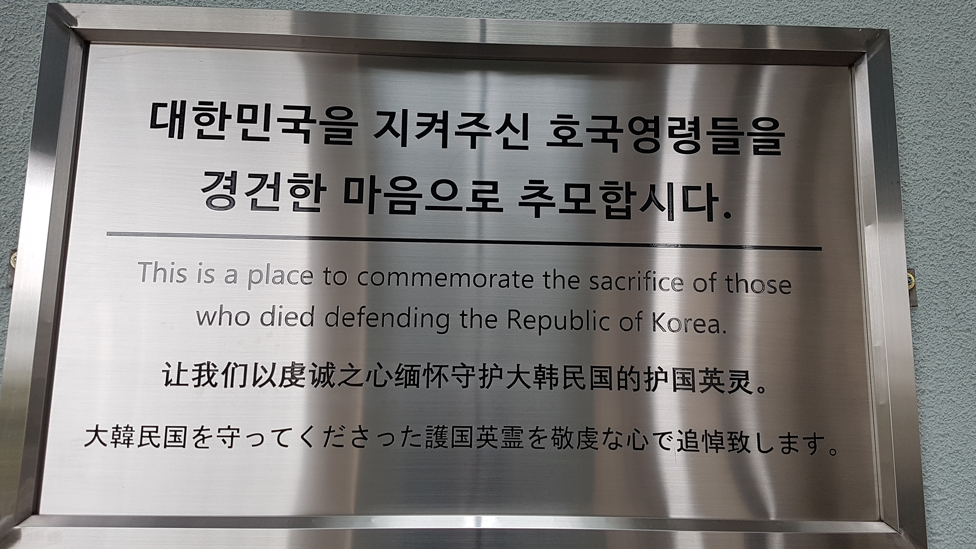
The explanatory board in the monuments for the Killed In Action at the War Memorial of Korea
The Plaza also has the Korean War Monument which is made up of two large columns which face each other, and which represent the Korean bronze dagger, the Sehyung Bronze Dagger.
This monument represents the long history, determination and strength of the Korean people to survive and thrive even through immense hardship.
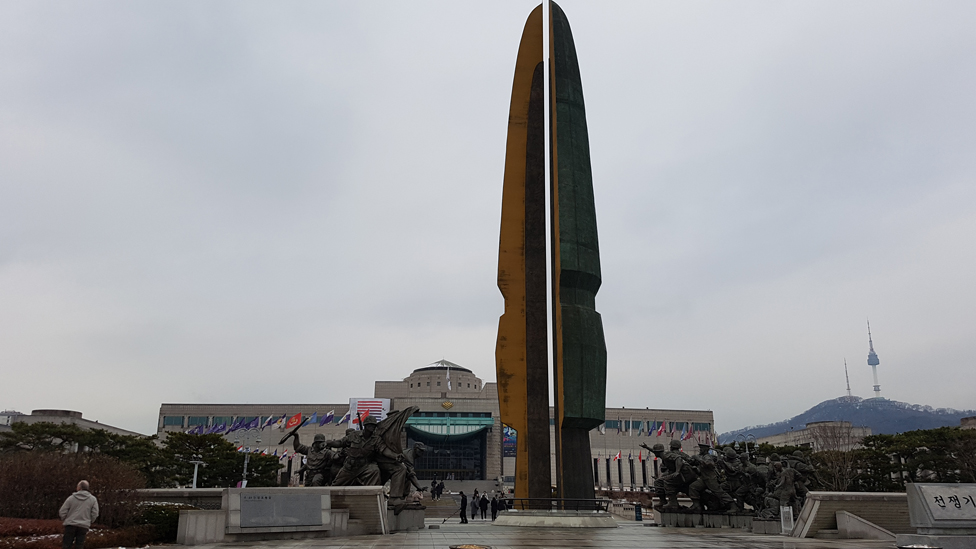
Monument in the Plaza at the front of the War Memorial of Korea
On the left and right hand sides of this monument is the Defending the Country statue.
This depicts in a dramatic manner 38 people from different sectors and classes of society who took part in the War.
It symbolises their sacrifice and patriotism as well as their determination to defend their country and their fellow citizens.
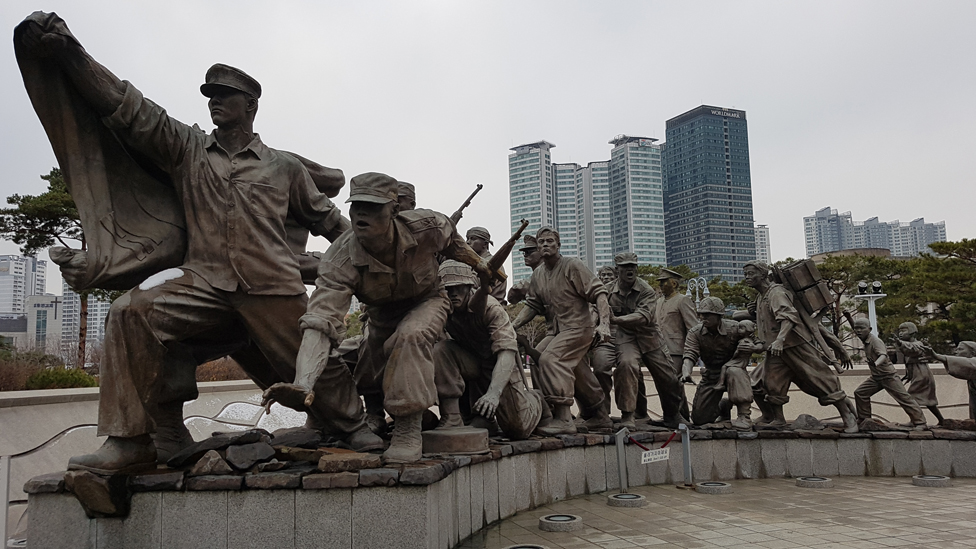
Part of the Defending the Country statue in the Plaza
The last part of this outdoor memorial is the Statue of Brothers which, because it stands with other symbolic sculptures and monuments, is part of a much broader process of commemoration and remembrance.
However, it is in many ways more meaningful and emotional for visitors because the Statue of Brothers represents a true story, one of family disagreement and despair, and has come to symbolise a divided nation as well as a divided family.
The statue recreates the moment when the elder brother, Second Lieutenant Park Kyu-chul, who was serving with the Republic of Korea (South Korean) 16th regiment in the 8th Division and the younger brother, non-commissioned officer Park Yong-chul, who was serving with the North Korean Army in the 83th regiment in the 8th Division, met while fighting against each other at the Battle of Chiak Hill in Wonju between December 1950 and January 1951.
Their embrace shows the older brother supporting his younger brother and together there is not just recognition but a sense of love and tenderness.
The statue of the brothers is immensely emblematic of the chaos and heartache brought by war.
The foundation for the statue is highly symbolic too.
The brothers stand on a concrete semi-circular dome which was built with pieces of granite collected from locations across South Korea.
This dome represents a tomb and the different pieces of granite symbolise the sacrifices made by all people in all regions of the country.
The crack in the dome’s roof represents the division of Korea and the hope for reunification.
On the floor inside the dome are maps of the countries which fought in the war to support the South.
A series of steel chains tied to the ceiling of the dome represent the unity of the Korean people and their desire for unity and never to be divided again.
Two murals within the dome express the national spirit and the fact that the Korean War was won because of the commitment of the whole nation.
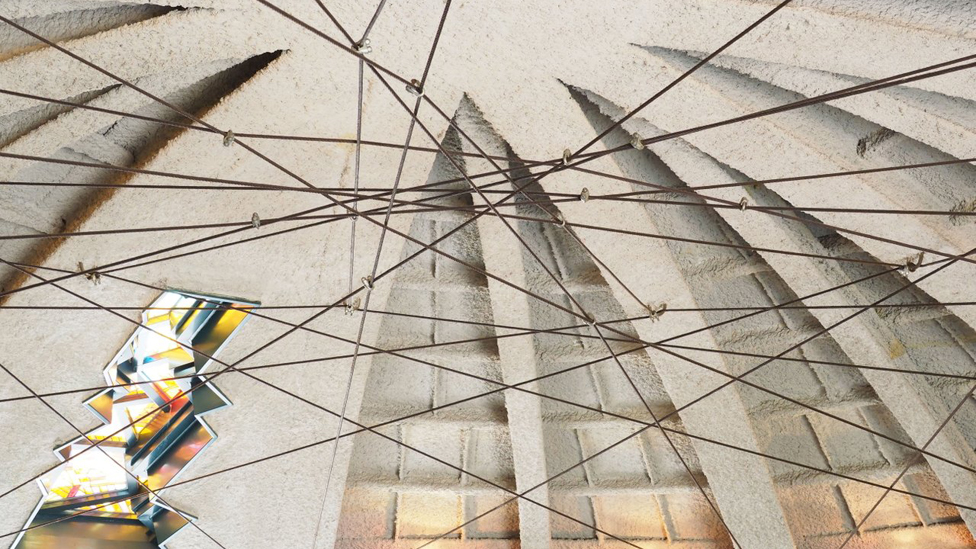
Inside the Dome under the Statue of Brothers
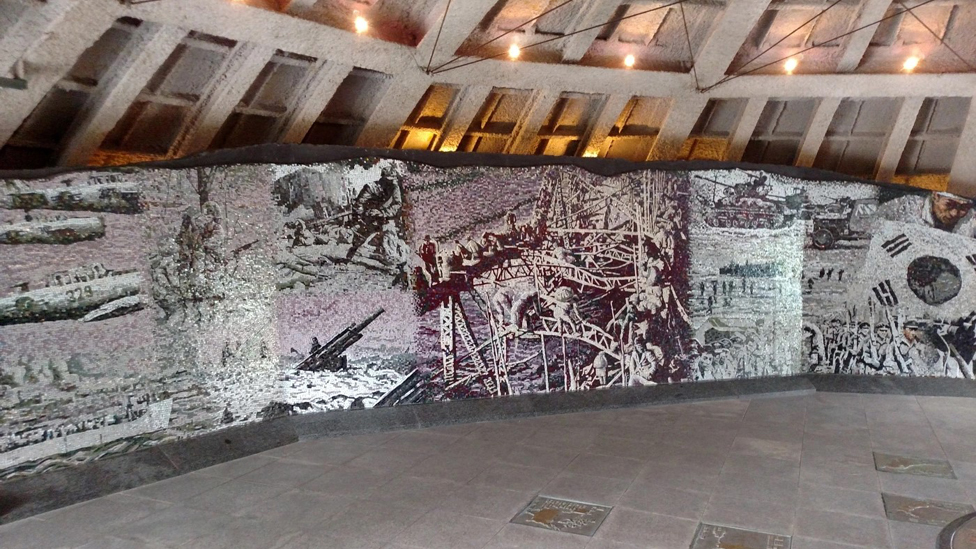
Inside the Dome under the Statue of Brothers
The Korean War has left a lasting impact on the people of both South and North Korea.
There has only been an armistice singed in 1953 – there has never been a peace treaty.
In effect, the two countries are technically still at war.
As a result, it is now appropriate to look at that war – its causes, events and consequences – so that the Statue of Brothers, the War Memorial of Korea and the whole process of commemoration and remembrance can be fully appreciated.
THE KOREAN WAR – CAUSES, EVENTS AND CONSEQUENCES
Background to the Korean War
During World War Two, Japanese forces had occupied Korea. After Japan’s defeat, it left the Korean peninsula, which was then split into two zones. The northern zone was occupied by the USSR; the south was occupied by the US.
The USSR set up a communist government in North Korea. The Americans set up a government friendly to themselves in South. The Soviet-backed leader of North Korea was named Kim Il Sung, whilst the American-backed leader of South Korea was Syngman Rhee.
On 25 June 1950, the North Korean army invaded South Korea, with the aim of creating one united – and communist – Korea. The North Korean army was provided with weapons and equipment from the USSR.
The Course of the Korean War
The South Korean army, supported by American troops who were stationed there, were pushed backed very quickly by the invading North Koreans.
The South Korean capital, Seoul, was captured quickly. Soon, the North Koreans had captured most of South Korea – and it looked as if the whole of Korea would become a communist country.

Main events of the Korean War © BBC
President Harry Truman – who said he was determined to stop the spread of communism – persuaded the United Nations to defend South Korea.
In September 1950, a United Nations army, led by an American general named Douglas MacArthur landed in South Korea (at Inchon) and began to push the North Koreans back.
In total, 16 countries sent troops to fight (including Britain, Thailand, Australia, France and Colombia) – but it was the US that provided the most by far.
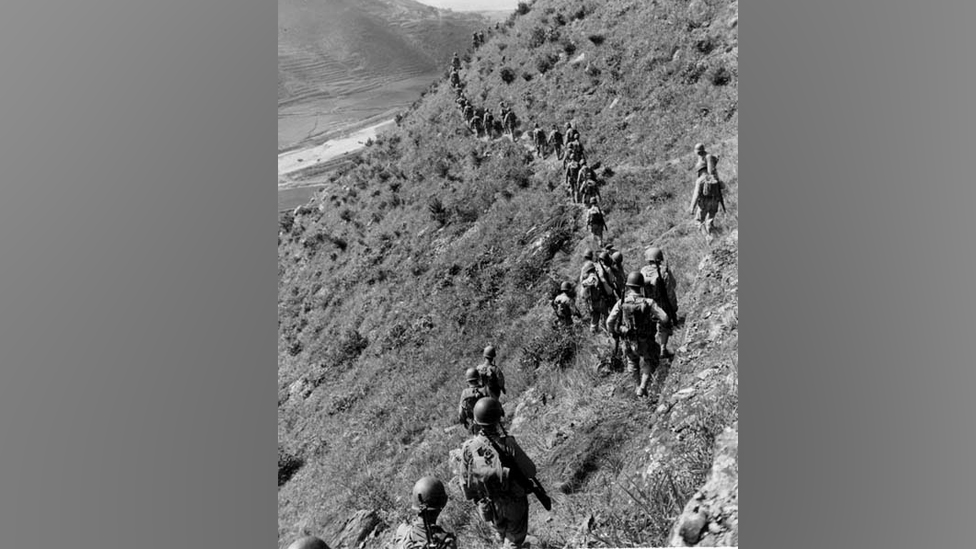
American soldiers advancing during the Korean War © US Marine Corps
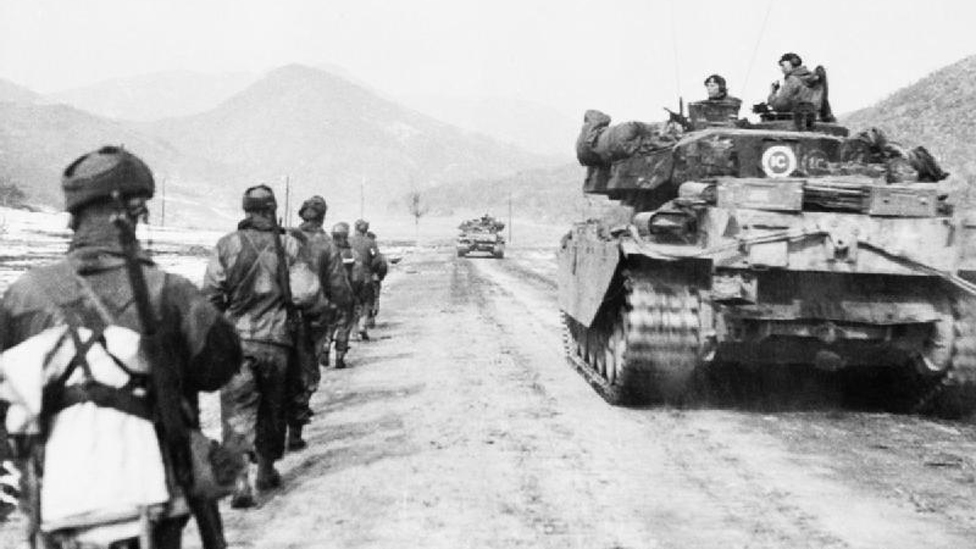
British soldiers, part of the Gloucestershire Regiment, and a Centurion tank, advancing towards Hill 327, March 1951 (Imperial War Museum Non-Commercial Licence)
By October 1950, UN troops had pushed the North Korean army back out of South Korea and captured most of North Korea,
China, which had become a communist country in 1949, felt threatened by the closeness of UN troops and launched a large-scale invasion of Korea. This forced the UN forces back again.
With the US strongly supporting UN forces on one side and the USSR and China supporting the other, the two sides were evenly matched.
By 1953, both sides were roughly at the same original place as they had been when the war began – the 38th parallel.38th parallel – a line of latitude which acted as the border between North and South Korea. The war had reached stalemate.
In July 1953 a ceasefire was agreed at Panmunjom.
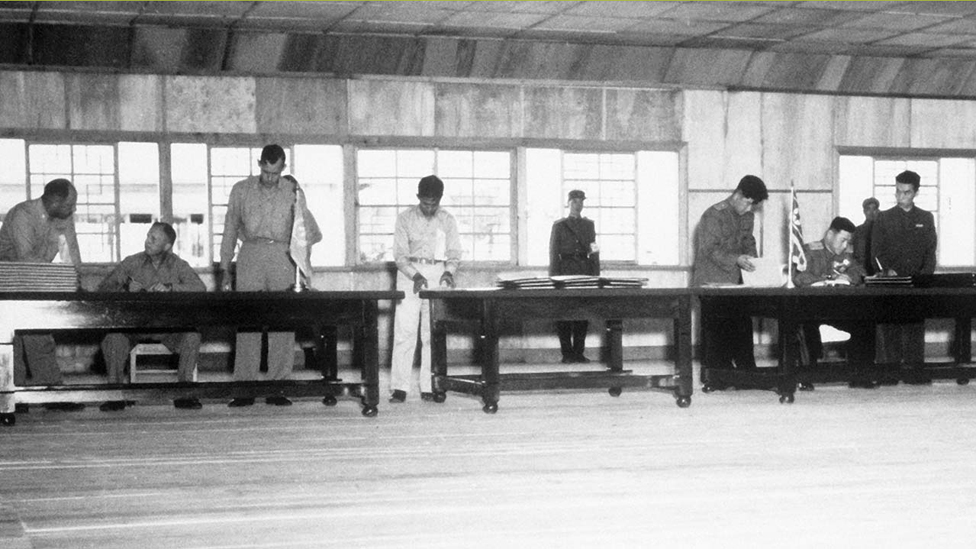
Signing the Armistice which led to a ceasefire in July 1953 (US Navy)
North Korea remained communist while South Korea stayed capitalist.
A heavily defended two-and-a-half mile wide DMZ (Demilitarized Zone) separates North and South Korea to this day.
Relations between the two Koreas since 1953
Acts of terrorism have added to these tensions. For example, in 1968, North Korean soldiers attempted to assassinate South Korean President Park Chung-Hee at the presidential mansion in Seoul.
And in 1987 the North was responsible for a bomb that destroyed a South Korean airliner, killing over 100 passengers and crew members.
Since this attack, relations between North Korea and South Korea have remained difficult, but some progress has been made in more recent years. For example, there has been several Inter-Korean summits where the two countries meet to discuss a more positive relationship.
However, North Korea’s efforts to develop a nuclear program has stopped any significant progress being made.
The impact of the Korean War, the significance of the War Memorial of Korea and the importance of the Statue of Brothers
The Statue of Brothers symbolically represents the history of modern Korea.
It marks the division of the peninsula into two countries which now set out on two very different paths of development.
South Korea has become an important democratic state, and an economic and industrial force in Asia, welcoming foreign culture and ideas.
It is a successful capitalist country, with large corporations exporting goods all over the world.
North Korea, on the other hand, is a Communist country.
Its economy is focused on supporting one of the world’s largest standing armies and it is estimated that the people have a much lower standing of living than those in the South.
The North Korean nuclear weapons programme has created concerns across the world and has led to much criticism from world bodies like the United Nations.
The statue also reminds people of the impact of the War, of the destruction and chaos it brought to all families and the division which occurred in some many communities.
For Korea, the war was a disaster.
Over two-fifths of its industrial facilities were destroyed, and one-third of its homes devastated.
It has been estimated that approximately 4 million people, most of whom were civilians, had been killed, wounded or were missing.
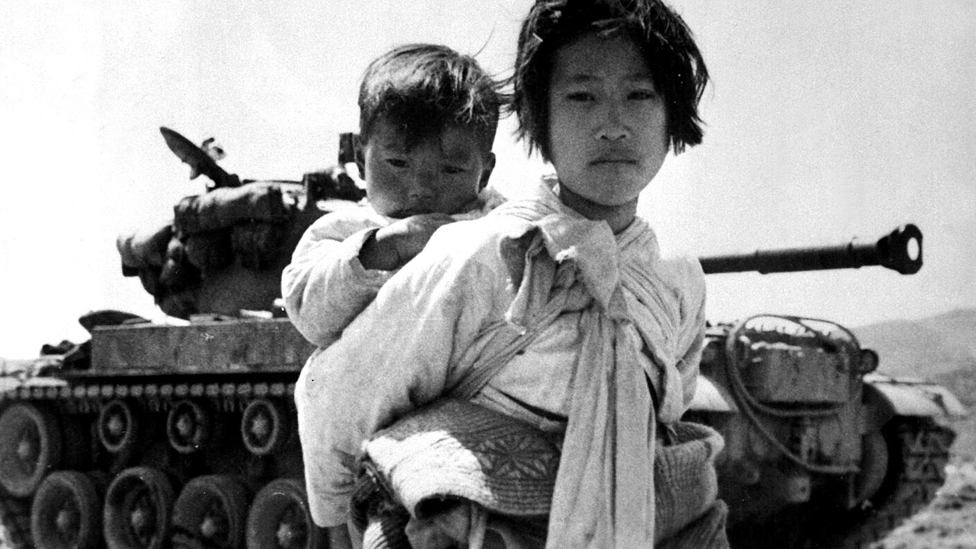
A photograph of a refugee carrying a baby in front of a tank (Library of US Congress)
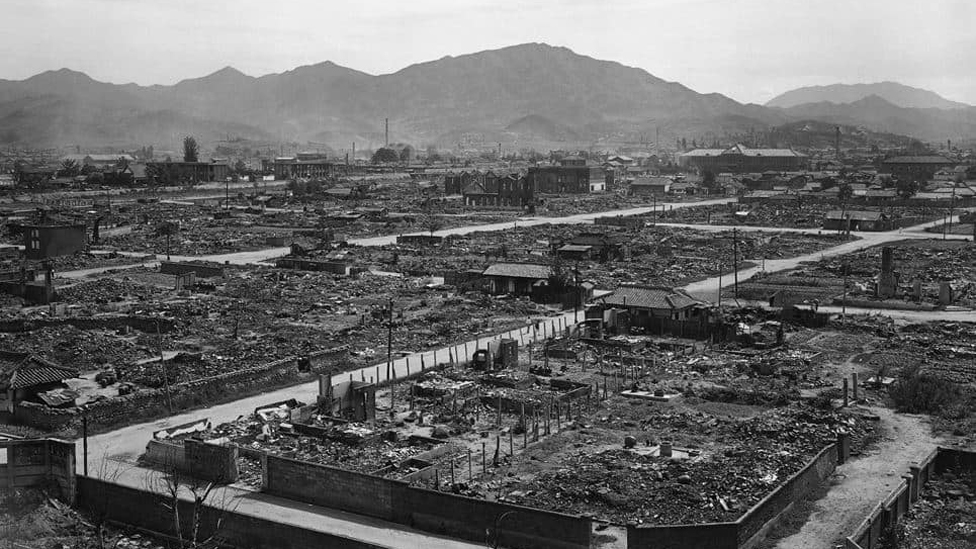
A photograph showing the destruction which resulted from the fighting, in this case of the city of Taejon (Daejon)
The combined casualties of South and North Korea are estimated to be over three million, or 10% of the total population. The United Nations sent about two million soldiers during the three years of war, of which some 40,000 died in combat and some 100,000 were wounded.
Reference: Korea in the World, AKS, 2017, page 30
This enormous contribution from countries around the World, as well as by the Korean armed forces and people, to support South Korea which is commemorated in the War Memorial of Korea.
Through the way in which the older brother supports his younger brother, the Statue of Brothers graphically shows the desire for reconciliation, love and friendship, and a desire for reunification.
It should be noted that the drive for reunification has waned somewhat in recent years in South Korea as younger generations have become more accustomed to a divided peninsula. The threatening actions of Kim Jong Un, the leader of North Korea, has done much to undermine the desire for reunification.
The murals inside the dome under the brothers also indicates the power of the people in working in unity to overcome immense hardship.
The war galvanised the people of South Korea and the Statue of Brothers and all the other parts of the War Memorial of Korea help people to remember the events so that they will never be forgotten.
They also help future generations to commemorate and honour those who gave their lives to help the South survive and later thrive.
For the people of South Korea, the conflict with North Korea is a turning point in their history and development.
It marks the start of a period in which the nation came together to use its determination, creativity, energy, and commitment to become a successful and democratic modern state.
However, within this process the past was not to be forgotten and the Statue of Brothers visually reminds them of that key moment, namely the Korean War, which was a period worthy of perpetual remembrance and commemoration.
Retrieval practice
1. What was the name of the Korean architect who designed the Statue of Brothers?
a) Choi Young-jeep
b) Lee Sung-gwan
c) Park Kyu-chul
2. In what year was the War Memorial of Korea opened?
a) 1974
b) 1984
c) 1994
3. In what month and year was a ceasefire to the Korean War agreed?
a) July 1950
b) September 1953
c) July 1953
War memorials
There are many thousands of war memorials all around the world, and they come in lots of shapes and sizes, made from many different types of building materials.
For example, there are estimated to be more than 100,000 war memorials in the UK alone.
Ask students to research at least three different types of war memorials, on at least three different continents.
This could be an individual or group project. It could be presented as a fact-file or PowerPoint presentation. Perhaps give students this structure:
- What conflict/war does the memorial commemorate?
- Facts about the conflict/war
- Basic facts on the memorial itself (location, size, designer, building materials etc).
- Interesting facts. For example, is there a reason why the memorial was located in a particular place, or designed in a particular way?)
- Add images
Examples of well-known memorials include: Arc de Triomphe (Paris, France); The Cenotaph (London, UK); India Gate/Delhi Memorial (New Delhi, India); Vietnam Veterans War Memorial (Washington DC, USA); Choeung Ek Genocidal Centre in Phnom Penh (Cambodia); Holocaust Memorial (Berlin, Germany).
War Memorial of Korea
- What they are (describe the item – include an image)
- Why they think they have been put on display in the War Memorial of Korea
- Why they think it is important to preserve objects connected to the war
The Korean War and the Wider World
It was the first “hot” war of the Cold War period. This means that fighting took place between Capitalist countries mainly led by the US and Communist countries, including China.
The Korean War involved soldiers from many countries. In fact, 16 countries provided soldiers to fight for south supporting United Nations. The North was supported by two main communist countries.
Ask your students to find out which countries were involved in the Korean War. For each country ask them to find out:
1. Which side they supported.
2. What kind of support they offered e.g., money, medicine, weapons, soldiers.
3. Whether they were directly or indirectly involved in the war.
Timeline
The Korean War was an important flash point of Cold War. The Statue of Brothers commemorates this war and offers hope of reunification.
To provide your pupils with some context for this object you could ask them to create a timeline of some of the key events in the Korean War. Choose some of (or perhaps all) of the following:
- The date that the North first invaded the South.
- The date that the US declared support for the South.
- The date that the United Nations Security agreed to support the South and send troops.
- The date(s) the Chinese involved themselves in the war.
- The dates (s) the Soviets involved themselves in the war.
- The period of stalemate.
- The date of the armistice.
Where else in the World
Ask pupils to research important people who lived at this time, or what other important events or developments took place.
For example in 1950, NATO was created and the first ever credit card was issued by Diners Club. In 1952 Queen Elizabeth II became Queen of the UK. Although it happened in 1955, it might be interesting for the pupils to find out that Rosa Parks refused to move seats, triggering the Montgomery Bus Boycott.
Classroom Extras
Here you will find a number of images, video clips and website links which can be used as extras for teaching in the classroom or for use by pupils undertaking independent research.
Images
This drum sits in the entrance to War Memorial of Korea. The display board states that “We made this drum to commemorate the 60th anniversary of the foundation of the Republic of Korea’s Armed Forces. The drum represents the Korean people’s hope that the advanced, elite and strong force would contribute to the world in the future. The tiger pattern represents the dauntless courage of the strong Korean Armed Forces”
A display board showing the number of soldiers killed in action for each UN country which participated in the Korean War to support South Korea
The outside display area at the War Memorial of Korea showing some of the large weapons used in the war – an American B52 bomber.
Map
Select Google Maps options to view locations for different objects:
Videos
Watch these films about the Statue of Brothers and the Korean War:

Discover more online
Wikipedia: An overview of the Statue
War Memorial of Korea: Official website
Google Arts and Culture: War Memorial of Korea: The official website of the War Memorial
Wikipedia: The film Taegukgi is a 2004 South Korean wartime action drama film and is loosely based on the story of the two brothers who are shown in the Statue of Brothers
Wikipedia: War Memorial of Korea

